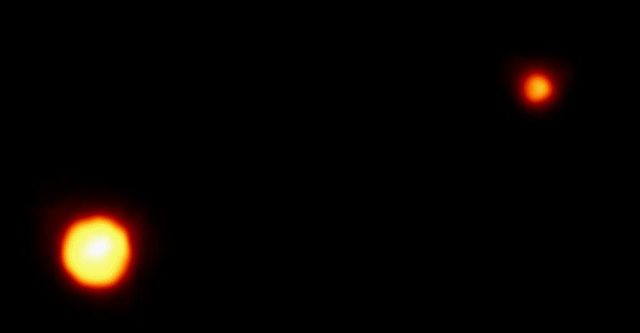 |
This is a file from the Wikimedia Commons. Information from its description page there is shown below.
Commons is a freely licensed media file repository. You can help.
|
Summary
| Description |
English: This is the clearest view yet (as of 1994) of the distant dwarf planet Pluto and its moon, Charon, as revealed by NASA's Hubble Space Telescope (HST). The image was taken by the European Space Agency's Faint Object Camera on February 21, 1994 when the planet was 2.6 billion miles (4.4 billion kilometers) from Earth; or nearly 30 times the separation between Earth and the Sun.Hubble's corrected optics show the two objects as clearly separate and sharp disks. This now allows astronomers to measure directly (to within about 1 percent) Pluto's diameter of 1440 miles (2320 kilometers) and Charon's diameter of 790 miles (1270 kilometers). The Hubble observations show that Charon is bluer than Pluto. This means that both worlds have different surface composition and structure. A bright highlight on Pluto suggests it has a smoothly reflecting surface layer. Though Pluto was discovered in 1930, Charon wasn't detected until 1978. That is because the moon is so close to Pluto that the two worlds are typically blurred together when viewed through ground-based telescopes. (If our moon were as close to Earth, it would be as big in the night sky as an apple held at arm's length). The new HST image was taken when Charon was near its maximum elongation from Pluto of 0.9 arc seconds. The two worlds are 12200 miles apart (19640 kilometers).
|
| Date |
21 February 1994 |
| Source |
http://hubblesite.org/newscenter/archive/releases/1994/17/image/a/ ( direct link) |
| Author |
Dr. R. Albrecht, ESA/ESO Space Telescope European Coordinating Facility; NASA |
Licensing
| Public domainPublic domainfalsefalse |
 |
This file is in the public domain because it was created by NASA and ESA. NASA Hubble material (and ESA Hubble material prior to 2009) is copyright-free and may be freely used as in the public domain without fee, on the condition that only NASA, STScI, and/or ESA is credited as the source of the material. This license does not apply if ESA material created after 2008 or source material from other organizations is in use.
The material was created for NASA by Space Telescope Science Institute under Contract NAS5-26555, or for ESA by the Hubble European Space Agency Information Centre. Copyright statement at hubblesite.org or 2008 copyright statement at spacetelescope.org. For material created by the European Space Agency on the spacetelescope.org site since 2009, use the {{ ESA-Hubble}} tag. |
|
File usage
The following pages on Schools Wikipedia link to this image (list may be incomplete):
SOS Children's Villages has brought Wikipedia to the classroom. SOS Children helps those who have nothing and no one, giving them back the famly they have lost and bringing them the very best opportunities for a happy, healthy future. Find out more about sponsoring a child.



